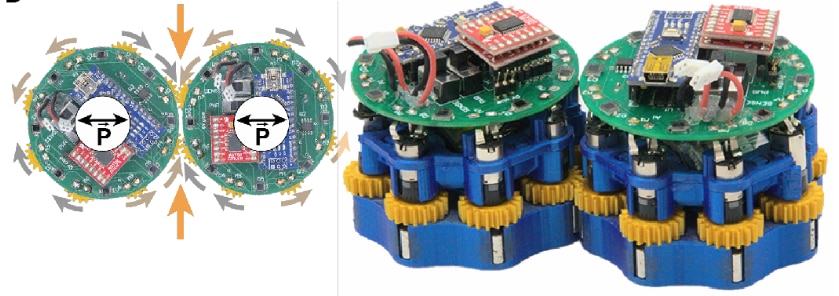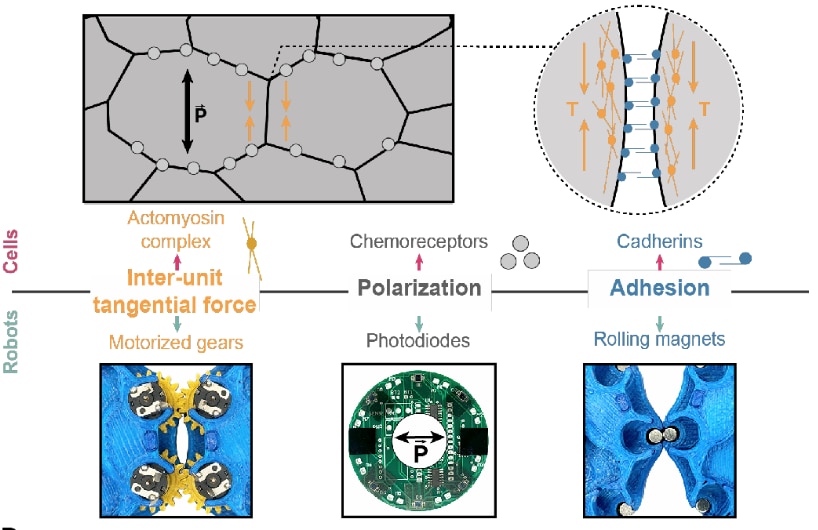
These tiny disk-shaped robots work together to lift and manipulate objects or support weight. (Image Credit: Brian Long/UCSB)
UC researchers sought inspiration from embryonic tissues to develop a swarm of robots that act like smart material. The disk-shaped robotic swarm self-assembles, switching from a fluid to a rigid state. These robots can then adapt dynamically, functioning similarly to biological processes like self-healing and self-shaping.
The challenge behind this swarm involved a material that flows, remaining stiff and strong when it requires a new form. Typically, robot materials change and hold shape via internal signals instead of relying on exterior forces. So, the team sought inspiration from former USBC professor Otger Campas’ previous work on embryos’ physical shape.
“Living embryonic tissues are the ultimate smart materials,” Campas said. “They have the ability to self-shape, self-heal and even control their material strength in space and time.” He realized that embryos melt like glass to shape themselves. To sculpt themselves, cells in embryos can make the tissues switch between fluid and solid states; a phenomenon known as rigidity transitions in physics,” he said.

Eight gears along each robot’s exterior allow them to push against or move around each other. (Image Credit: Devlin., et al./Science)
Each robot is equipped with eight motorized gears along its circular exterior, translating intracellular forces into inter-unit tangential force. With this configuration, the robots can move around and push off each other, especially in confined spaces.
In addition, they have light sensors with polarized filters to change form. This works similarly to how the cells of embryos change the tissue shape when lining alongside each other and elongating the body. Shining light on these sensors instructs the polarization to spin the gears in a certain direction, enabling the shape-changing process. “You can just tell them all at once under a constant light field which direction you want them to go, and they can all line up and do whatever they need to do,” Mattew Devlin, a former doctoral researcher in the lab of UCSB mechanical engineering professor, said.

The robots have similar functions as the embryo cells. (Image Credit: Devlin., et al./Science)
The team integrated turning magnets into the robot’s perimeter to attract other robots, mimicking the cell-cell adhesion. During tests, the team discovered that signal fluctuations affected how the materials take shapes and formations.“We had previously shown that in living embryos, the fluctuations in the forces that cells generate are key to turning a solid-like tissue into a fluid one. So, we encoded force fluctuations in the robots,” said Campàs.
Those signal fluctuations enable the robot swarm to change its strength and shape with less average power compared to keeping the signal active and the robots pushing on each other. “It’s an interesting result that we did not set out looking for, but discovered once we started gathering data on the robot behaviors,” Elliot Hawkes said. This is crucial for robots designed to run on limited power budgets.
The team also manipulated the robots to behave like a smart material. Parts of the swarm turned on dynamic forces between robots and fluidized the swarm. Meanwhile, robots in other areas held onto each other, forming a durable material. Regulating those behaviors over time and across the swarm allowed the team to produce robotic materials with heavy payload support. It also reshapes, manipulates objects, and self-heals.
Although the proof-of-concept robot collective only has twenty large units, simulations suggest the system can be scaled to include additional mini units. This helps achieve a materials-like quality. Along with similar robotic swarms, this project could “enable the study of phase transitions in active matter, the properties of active mechanics in particulate systems and potentially help define hypotheses for biological research,” according to the paper. Integrating current controls and machine learning could enable these robotic swarms to develop new abilities in robotic materials.
Have a story tip? Message me at: http://twitter.com/Cabe_Atwell
